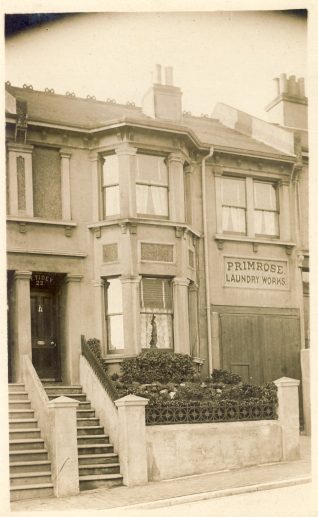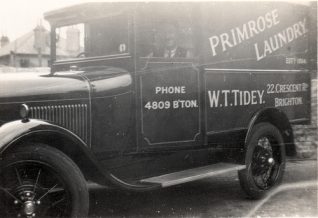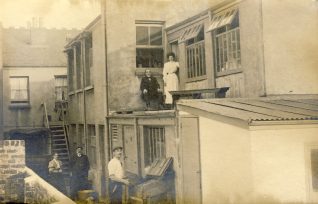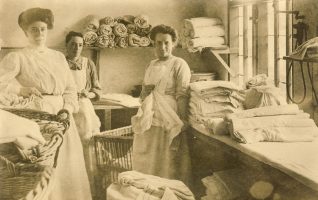Primrose Laundry, 22 Crescent Road






The Primrose Laundry at 22 Crescent Road was founded by my great-great-grandparents, William and Sarah Tidey, known to her family as Sally. They moved into the newly built house and premises in the late 1890s. (The odd-numbered side of Crescent Road was built in the 1880s, and the even-numbered side a decade later.) The laundry was named Primrose because William was a member of the Primrose League, a political organisation that supported Disraeli. Every year, the anniversary of Disraeli’s death (April 19) was declared Primrose Day and the laundry staff had the day off.
Sarah ran the business.
William was officially the laundry proprietor, but it was Sarah who ran the business. William had been a sergeant in the Royal Artillery, pensioned off due to ill health in his early 30s. He suffered severe psychotic episodes after serving with his regiment in India and spent long periods in the Brighton Borough Mental Hospital at Haywards Heath. Sarah took in washing to support herself and their three small children. She was already a ‘laundress’ in Richmond Road in the 1880s.
Childhood visits to the laundry
William died in 1911. By the time Sarah died, in 1932 at the age of 78, the laundry was run by her daughter Maud and son-in-law Thomas Hills. I remember visiting as a child in the 1950s and ’60s. The double doors below the Primrose Laundry Works sign opened to a carriage arch that led up a steep slope, past the kitchen door to the laundry works and a yard with a garage.
The laundry works were attached to the back of the house. They could also be reached from within the house, through a door on the first floor.
A door-to-door service
On work days, the laundry smelled of steam and soap and was noisy with female voices, the clank of machinery, and the hissing of the press that ironed newly washed sheets. I recall only one male employee, who drove the delivery van (originally horse-drawn). The laundry provided a door-to-door service, sheets and shirts were collected from customers’ houses and returned as ‘brown paper packages tied up with string’. In the early 1900s, the van driver had been Tom Hills. By the 1950s it was a man called Phil.
Large kitchen with a cooking range
The house had a smart front room, with an upright piano and a framed painting of a woman anxiously watching storm clouds over the sea. There was a large kitchen with a cooking range, a dresser, a wall clock with a loud tick, and a long wooden table where all meals were eaten. The kitchen always smelled of the boiled fish that Auntie Maud fed her cat. Another person lived in the house. We knew her as Auntie Ethel. One day I asked my mum why Auntie Ethel called Auntie Maud ‘My lady’. Turns out that Auntie Ethel was a servant. Miss Ethel Winter lived with and worked for the family her entire adult life. The Primrose Laundry remained in business until Tom died in 1962. Maud and Ethel continued to live at 22 Crescent Road till the end of the 60s.
No inherited wealth
It is surprising that the Tideys had owned the premises. William and Sarah had both grown up in the North Laine, their fathers working at or near Brighton railway station, one as a carpenter, the other as a warehouseman. Before her marriage, Sarah was a live-in servant in Montpelier Terrace. There was no inherited wealth and William’s mental illness drained their modest savings after his discharge from the army.
A freehold land society
They may have bought the property through a freehold land society. This was a form of building society that bought land for housing development. Members of land societies bought shares through monthly subscriptions, redeeming them in exchange for a building plot. The Conservative Land Society had drawn up a plan for the Roundhill Estate as early as 1853 (available at The Keep, ref no. BH800160). Subscriptions to shares in the Roundhill Estate cost 8 shillings per month, but business premises were prohibited, so I am not certain of this.




Comments about this page
Please note: with the exception of the image from Step Back In Time, all the photographs are from a private collection.
Add a comment about this page